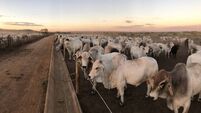Precision fertiliser: Delivering the right rate in the right place will be the key to 2022

Liam Fitzgerald, a lecturer at Kildalton Agricultural College, stressed that it was critical that fertiliser spreaders are set up correctly this year
Failing to set the spinner to the correct height is one of the most common fertiliser spreading errors costing Irish farmers in wasted fertiliser, Teagasc advisors have highlighted.
CSO figures released this week show a 134% increase in the price of fertiliser over the last year. The Agricultural input price index rose by over 28% in the year from February 2021.
However, the agricultural output price index lagged behind, up by just over 19% in the year from February 2021, making it more important than ever. Making a large first cut of silage will be vital for the winter ahead and needs to be planned, with the time fast running out to boost the growth of this year’s first cut.
“With the continued increase in the cost of fertilisers, it is critically important we use fertiliser as efficiently as possible – from good fertiliser set-up to applying them under the right conditions to maximising the return from a very expensive input on the farm,” Teagasc advisor Mark Plunkett said.
Speaking during Teagasc's Precise Application of Fertiliser event, Tim Sheils, president of the Fertiliser Association of Ireland, said that political instability and commodity markets had led to a four-fold increase in prices for many merchants.

“The price of gas steadily increased all of last year, which had knock-on effects for production, where we had some countries close down production,” he said. “Other countries then put on export bans on fertiliser, putting further stress on getting product into the Irish market.
“Fertiliser was already going to be very difficult this year. Then, the Russian conflict has further exacerbated the situation.”
Mr Sheils advised farmers to contact their merchant early, establish a fertiliser plan for their farm, and prioritise lime on fields with a pH under 6.
Liam Fitzgerald, a lecturer at Kildalton Agricultural College, stressed that it was critical that fertiliser spreaders are set up correctly this year, talking through some of the most common mistakes made by tractor operators.
“The first step to spreading evenly and accurately is having a machine that is well-maintained, in good working order and set up properly on the back of your tractor,” he said. “Make sure the spinning discs are moving freely – that they are not seized and that the bearings aren’t loose on the machine.
“If you’ve got an oscillating spout machine, the principles are the same. Make sure there is no excess wear on the veins of the discs, that will have an impact on how even that machine will spread.”
Adjusting the flow rate of the machine is also important.
“You will want to set different rates across different crops,” Mr Fitzgerald said, highlighting that it was important to make sure the shutter doors at the bottom of the hopper are opening and closing freely and equally.
“Your agitator in the bottom of the hopper has an important function, in terms of ensuring a consistent flow of fertiliser from the hopper onto your disc so make sure it is functioning properly.” Boundary systems, like deflectors, should also be tested to ensure they are calibrated correctly.
“Regularly washing the machine – after every use, if possible. Fertiliser is a very corrosive product. It will cause rust and issues with the machine if you don’t wash it properly,” Mr Fitzgerald said.
“Refer to the operator’s manual to determine what components need to be greased, and how often. You could even apply a coat of anti-corrosive oil to your machine just to prolong its life.”
The spinner should sit “dead centre” when attached to the tractor. The best guide for that is making sure your top link is straight,” Mr Fitzgerald said.
“You want a maximum sway on your link arms of no more than 5cm. Setting the machine at the correct operating height has a huge impact – if you get that wrong it will affect your spread width, and also how even your fertiliser spreads.
“Refer back to the fertiliser tables to get the correct height. The point you measure from does depend on the machine.” Mr Fitzgerald explained it was also important the spinner was set up level.
“If you can imagine a machine leaning to the right, one disc is throwing fertiliser towards the ground, while the other is throwing it higher into the air,” he said.
“You need your machine as level as possible left and right – and ensure it is at the same height at the front as it is at the back. If you have it pitched up at the back, the fertiliser may be travelling further than you want.
"There will be occasions on certain machines where you want that higher pitch at the back, if you need to get a wider spread width, but for the majority of conditions, you want your machine level from front to back.”
Mr Fitzgerald also highlighted it was important that operators took steps to reduce the risk of a farm accident, using a blade on the end of a stick to allow them to open the fertiliser bag without reaching under the bag.











